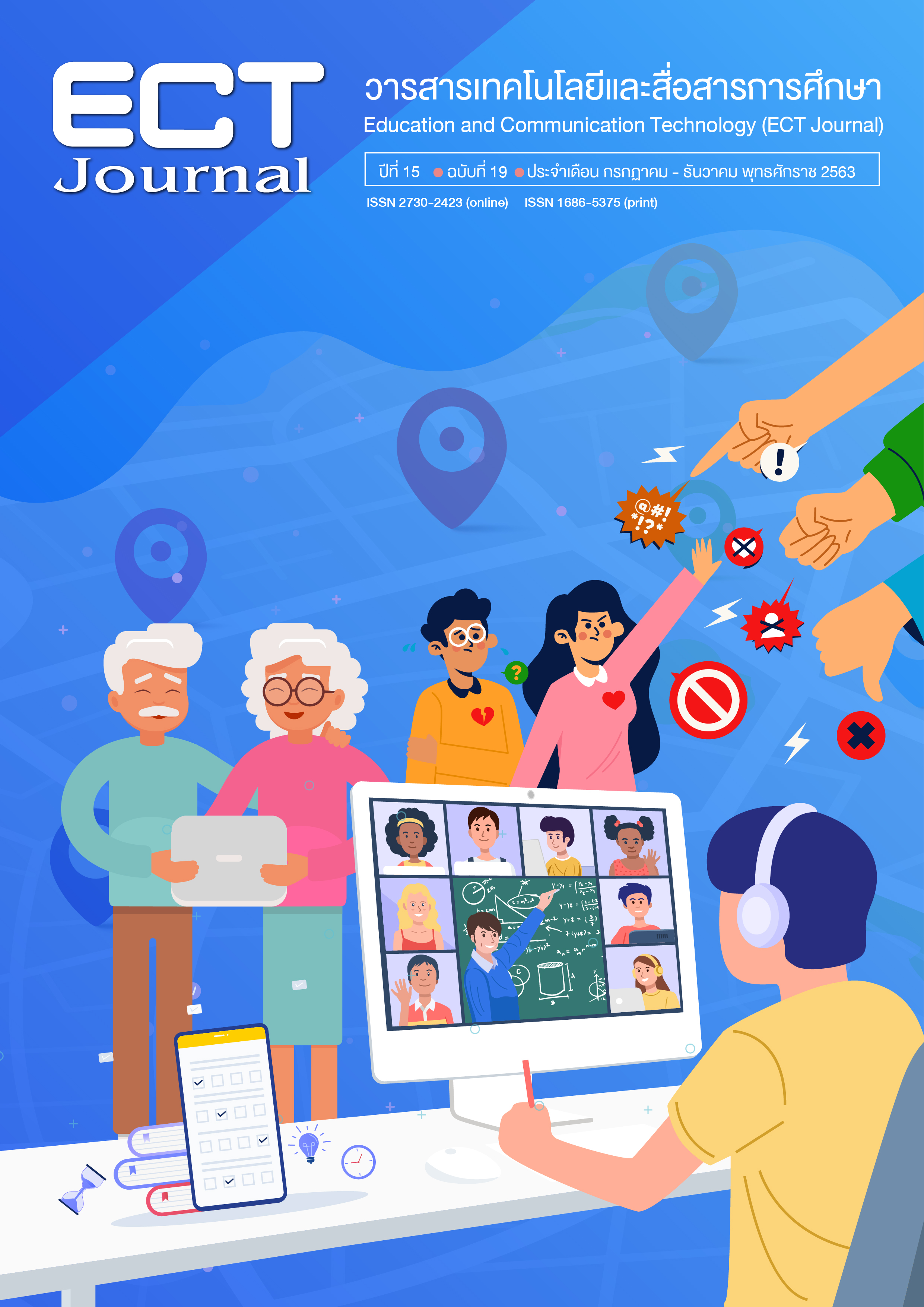To Promote Awareness about Cyberbullying and Hate Speech for Basic Education Students: Case Study in Chachoengsao School
Keywords:
Cyberbullying, Hate SpeechAbstract
The purposes of this research were to 1) study students’ behaviour and 2) promote awareness about cyberbullying and hate speech for basic education students in Chachoengsao Province. The samples were (1) 10 teachers and 43 students who were responding to the survey stage to construct the questionnaire form and (2) 29 secondary-5 students in the second semester of the academic year 2019 at a school in Chachoengsao Province, responding to the try out stage. This research was conducted during the samples’ class and social media time in their daily lives to modify students’ behaviour about cyberbullying and hate speech. The experimental instruments consisted of the achievement test and value clarification Test which the researchers had developed through the survey stage. The findings were as follows: (1) The survey stage revealed that there were 24 important points. Important issues had been divided as follow; students built relationships through the use of information technology platforms to hand in their tasks, play games, and online or offline chats by the most using of Facebook, YouTube, and Line. They used the platforms at their residences. Most students spent 4 hours a day for the internet. Their conversations on social media were mostly rude. Most students showed their hate speech behaviors on social media by using rude, reviled or mocking words, and unserious teasing behaviors. When mentioned in negative ways, they promptly responded to those arguments. After writing negative messages on social media to their friends, most of the students felt uncomfortable but they thought that they could resolve themselves in a short time. All of the students had been bullied by teasing speeches and exposed their personal information on social media. Half of them had been bullied by impersonation on their accounts. The other half were never bullied. And this research found that 6-main-element and 2-main-step forms (2) The try out stage revealed that the samples’ achievement mean scores were significantly higher than pretest at the .05 level. There were 29 students, 100 percent, having value awareness about cyberbullying and hate speech and 23 students, 86.21 percent, having value clarification.
References
กรุงเทพฯ. เข้าถึงโดย https://www.etda.or.th/content/stop- cyberbullying-2019.html [10 มกราคม 2563]
กลุ่มบริษัท บีอีซีเวิลด์ จำกัด (มหาชน). (2563). ศธ.360 องศา: 'การบูลลี่'ปัญหาของเด็ก Gen Z. เข้าถึงโดย https://www.youtube.com/
watch?v=blC98ZssKVM&feature=youtu.be [10 มกราคม 2563]
ก่อ สวัสดิ์พาณิชย์. (2535). มองการศึกษา: เส้นทางที่เท่าเทียมของคนไทย. กรุงเทพฯ: สำนักพิมพ์แห่งจุฬาลงกรณ์มหาวิทยาลัย.
เว็บไซต์วิซเคส, 2020. (2020). 23 สถิติที่น่าอัศจรรย์ในอินเทอร์เน็ตและสื่อสังคมในปี 2020. 1 มิถุนายน 2020. เข้าถึงโดย https://th.wizcase.com/blog/สถิติที่น่าอัศจรรย์ใน [4 มิถุนายน 2020]
ทีมข่าวเฉพาะกิจไทยรัฐออนไลน์. กำจัดวงจร “ไซเบอร์ บูลลี่”. ไทยรัฐออนไลน์. เข้าถึงโดย https://www.thairath.co.th/scoop/1753691. [27 มกราคม 2563]
นาตยา ปิลันธนานนท์. (2539). การพัฒนาค่านิยม: การทำความกระจ่างใน ค่านิยม เอกสารการสอนชุดวิชาจริยศึกษา หน่วยที่ 9-15. มหาวิทยาลัยสุโขทัยธรรมาธิราช.
เบญจพร ตันตสูติ. (2562). ความน่ากลัวของ ‘ไซเบอร์บูลลี่’ ภัยใกล้ตัวที่ไม่ควร มองข้าม. 16 ตุลาคม 2562. เข้าถึงโดย https://www.tnnthailand.com/content/19166. [4 มิถุนายน 2020]
สถาบันสื่อเด็กและเยาวชน. (2561). เมื่อวาจาทำร้ายใจกัน...การเดินทางจาก “Hate Speech” สู่ “Cyberbullying” เอกสารการสื่อสารที่สร้างความเกลียดชัง (Hate Speech) และการศึกษาการรังแกกันบนโลกไซเบอร์ของวัยรุ่น. เข้าถึงโดย
https://www.healthymediahub.com/media/detail/เมื่อวาจาทำ
ร้ายใจกัน-การเดินทางจาก-Hate-Speech-สู่-Cyberbullying
[11 เมษายน 2561]
Downloads
Published
How to Cite
Issue
Section
License
1. ทรรศนะและข้อคิดเห็นใด ๆ ที่ปรากฏอยู่ในวารสาร ECT Education and Communication Technology Journal เป็นของผู้เขียนโดยเฉพาะ สำนักเทคโนโลยีการศึกษา มหาวิทยาลัยสุโขทัยธรรมาธิราช และกองบรรณาธิการไม่จำเป็นต้องเห็นพ้องด้วย
2. กองบรรณาธิการของสงวนลิขสิทธิ์ในการบรรณาธิการข้อเขียนทุกชิ้น เพื่อความเหมาะสมในการจัดพิมพ์เผยแพร่






